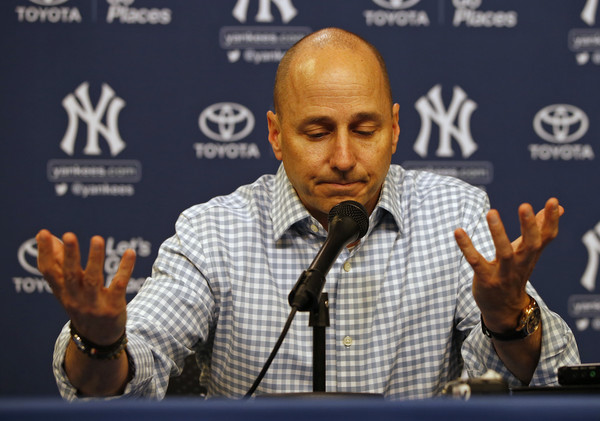
What a difference a month makes, huh? Through June and early July, the Yankees have suffered both injuries and insults–mostly in the form of bullpen meltdowns–on their way out of first place in the AL East. Still, they’re in playoff position as they lead in the wildcard spot, which is of comfort; they are also within striking distance of the now first place Red Sox with plenty of baseball left to play. In a vacuum, this team would be in buy-like-crazy mode, especially given the problems its had at first base all year and the bullpen recently, not to mention the rotation. Like always, though, there isn’t a vacuum and there’s a big mitigating factor at play.
This success–however tempered by the last five weeks or so–is unexpected. 2017 was not the year the Yankees were supposed to compete for anything more than a shot at the second wildcard. Now, the playoffs seem a real possibility. While that’s great for obvious reasons, it does somewhat betray the long term plan the organization had going into this year. Once again, the team will have to strike the delicate balance that defines the Yankees: win now AND later. They’re finally set up to do the latter more than the former, but they’ve also managed to do the former.
How the Yankees could buy is obvious. By all accounts, their farm system is–at worst–top five in the league. Even with Gleyber Torres injured, they have a blend of depth and upside in the minors that is (likely) the envy of many around baseball. Should they choose to, the Yankees could deal from a position of strength and depth by upgrading the major league roster at the expense of the minor league one.
But what happens if the Yankees continue to slip? It’s not likely as they’ll soon have players like Starlin Castro and Matt Holliday rejoining them from the disabled list, but let’s play what if. What if the Yankees find themselves in a position to sell again? Ask this a month ago–which was unthinkable at the time, really–and things would’ve seemed a lot better. Despite that, the Yankees do have some valuable pieces they could auction off.
The cons of trading all of these players are obvious–the Yankees need them for the stretch run. Each may have his own reasons, too, but that’s the overarching one.
First up are those two who’ll be returning: Matt Holliday and Starlin Castro. Both have obvious value as bats in any lineup, especially contending ones. Holliday, though, would likely be limited to AL teams. As for Castro, many might recognize this as the absolute top of his market–despite the injury–and avoid paying said cost.
Tyler Clippard would be next, but he completely demolished his own value over the last month plus, pitching like someone who hardly belongs in the big leagues.
Then there’s the real wildcard, Masahiro Tanaka. While he was shaky to start the year, that’s clearly atypical of him; he’s proven his mettle and worth over the last three plus seasons and on talent alone, he’s probably the Yankees’ best Major League trade piece not named Judge, Sanchez, or Frazier. But with his opt out, his trade value is diminished. No one likes uncertainty.
In all likelihood, the Yankees will not be sellers at this deadline. They’re going to be close and they’re going to owe it to their players to give an honest shot at things, even if this is ahead of schedule. If they’re lucky, they can maybe pull off the best of both worlds: improve the major league team by dealing prospects and selling off a major league piece to help replenish the minor league depth. That’s probably a pipe dream, but this season has sort of been one itself, hasn’t it?
Leave a Reply
You must be logged in to post a comment.